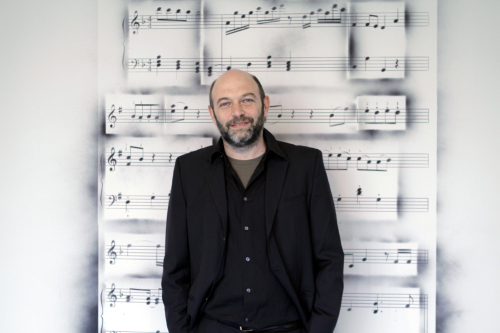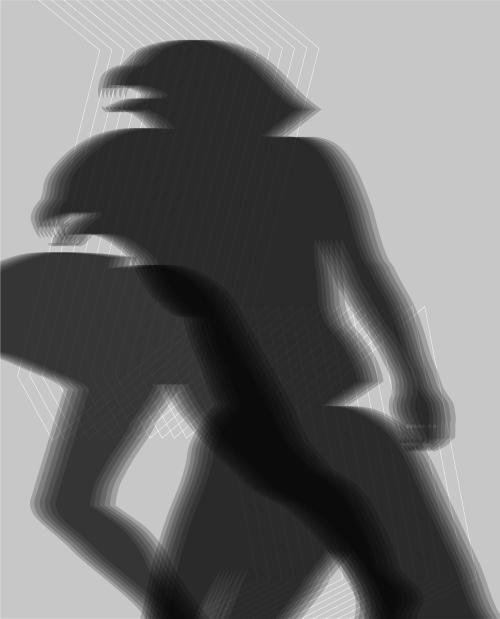Mexican artist melds media, time, fantasy and reality at solo show in Seoul
The ancient Egyptians were not the only ones who liked to put animal heads on human bodies.
Mexican artist Carlos Amorales also enjoys creating “manimals,” his own term for the half-human, half-animal creatures, through different media such as photograms.
Photograms are photographic images made without using a camera. When an object is placed on photographic paper and light is flashed on it, it leaves a negative shadow image. It was a process used by photographers of bygone generations, most significantly by Man Ray. The images are also referred to as rayograms.
“The body is actually that of my wife and the bird head is from some photos I took during trips. Mixing is a traditional way of expressing a fantastic form. Every culture, like Egypt, has the tradition. I think we can all relate to that,” Amorales told The Korea Herald at SongEun ArtSpace in Cheongdam-dong, southern Seoul, on Friday.
The ancient Egyptians were not the only ones who liked to put animal heads on human bodies.
Mexican artist Carlos Amorales also enjoys creating “manimals,” his own term for the half-human, half-animal creatures, through different media such as photograms.
Photograms are photographic images made without using a camera. When an object is placed on photographic paper and light is flashed on it, it leaves a negative shadow image. It was a process used by photographers of bygone generations, most significantly by Man Ray. The images are also referred to as rayograms.
“The body is actually that of my wife and the bird head is from some photos I took during trips. Mixing is a traditional way of expressing a fantastic form. Every culture, like Egypt, has the tradition. I think we can all relate to that,” Amorales told The Korea Herald at SongEun ArtSpace in Cheongdam-dong, southern Seoul, on Friday.

“(Manimals) are always a strong motive for me to work with. It is something in between. Culturally, I think we all live in between, in mixed times like modern shifting to postmodern and analog changing to digital, where everything is always changing.”
Though he is not well-known in South Korea, Amorales is quite an established artist in Europe and America known for his concise yet somewhat spooky artworks that cover a wide range of media. He has held solo exhibitions in world renowned galleries and museums such as the Museum of Modern Art in New York and the Tate Modern in London.
His first-ever solo exhibition in Seoul, “Carlos Amorales: Silent Films,” is currently running at SongEun ArtSpace. It is a good chance to get to know the artist because Amorales is showcasing his latest works which are milder compared to his more intensive pieces, and so less shocking for first-timers.
Viewing the 25 drawings, 14 photograms, two video works and many installations, visitors will soon realize that animals and people are not the only things the artist likes to fuse.

The ultimate use of mixing is in his silent films, a genre Amorales said he really likes because he can put together every possible medium and idea.
Two silent films are screened in a little black room on the fourth floor. “Discarded Spider” shows the artist bending and stretching what looks like a spider web made of wires and “Work Tools” showcases various plastic stencil patterns that he used to make other works.
“What is so great about working with different media is that I don’t become a specialist with one medium. Though, I think I am more graphic artist-minded. I am not a painter or a sculptor,” said Amorales.
To get into the black room, visitors have to pass by a noisy section where two or three performers are singing their lungs out, following musical scores sprayed on the walls. It is a performance accompanying the “Graffiti Songs” series which Amorales came up with during his first visit to Korea in February.
“It was very inspiring to see signs all over the place which I couldn’t understand. I could only see it visually. It was the same with the Korean language. I don’t understand it, so it was like music to me,” said Amorales.
He made a musical collage by cutting up parts from existing songs and rearranging them on the wall in a form of graffiti. He then threw a pile of the musical note stencils he used in the process on a table, as if they had fallen out of the scores on the walls.
Amorales said that all of the blending eventually fit into one main subject he focused on for this show: figuring out how fantasy plays with reality.
“I always feel that the fantasy world and history are very closely related. It is almost as if they correspond to each other, that fantasy is the sublimated version of history. We need fantasy to build a new world ― it is used to scare or deal with reality when it gets boring,” said Amorales.
This is the first special exhibition organized by SongEun ArtSpace, which SongEun Art Foundation opened last October. The foundation is better known for its annual SongEun Art Awards which marks its 10th this year.
The exhibition runs through May 21 at SongEun ArtSpace in Cheongdam-dong, southern Seoul. Admission is free. For more information, call (02) 3448-0100 or visit www.songeunartspace.org.
By Park Min-young (claire@heraldcorp.com)







![[KH Explains] How should Korea adjust its trade defenses against Chinese EVs?](http://res.heraldm.com/phpwas/restmb_idxmake.php?idx=644&simg=/content/image/2024/04/15/20240415050562_0.jpg&u=20240415144419)










![[Today’s K-pop] Stray Kids to return soon: report](http://res.heraldm.com/phpwas/restmb_idxmake.php?idx=642&simg=/content/image/2024/04/16/20240416050713_0.jpg&u=)